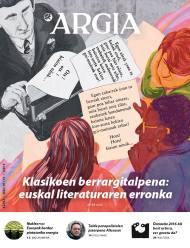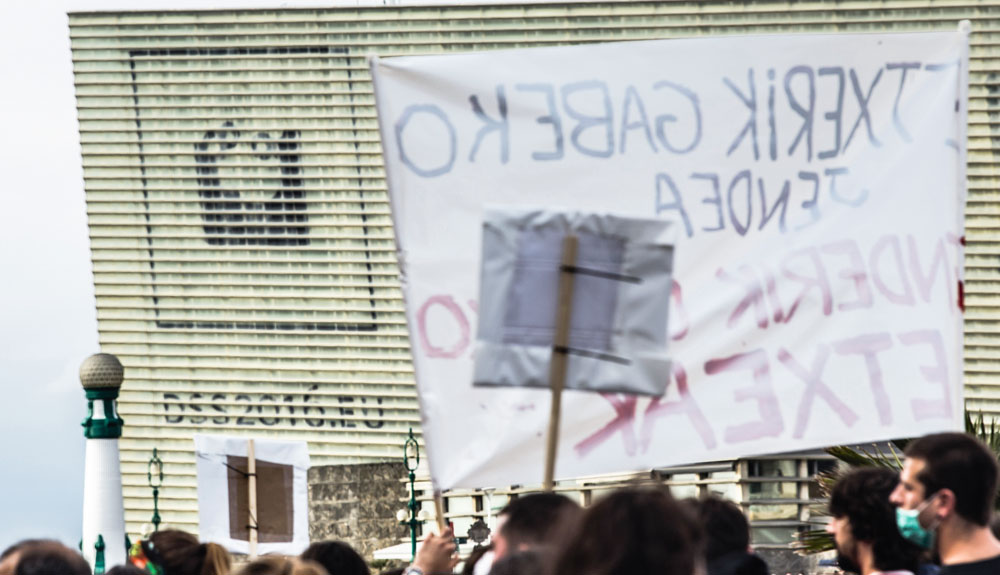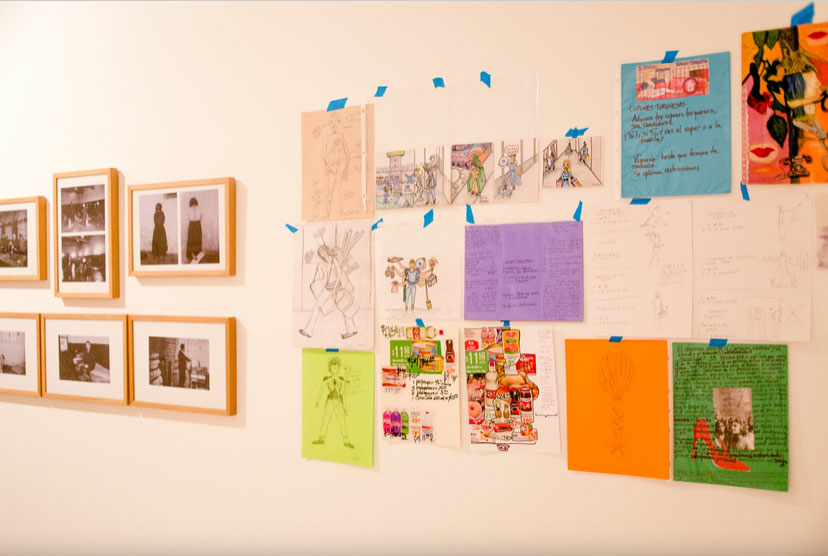A year in which culture wanted to transform the city
- We have been hearing “San Sebastian 2016” for years. European cultural capital, wave of citizen energy, culture of coexistence... After the great words, it was a process full of crises and conflicts. Who does not remember that hug between Odón Elorza and Juan Karlos Izagirre in 2011? Since its inception, it had the vocation of being “different” from the rest of the cultural capitals, placing the objective on the road. And in legacy. But it's been five years, and where is the famous legacy? This report was published by Irutxuloko Hitzak and was brought with the Creative Commons BY-NC-ND 4.0 license.
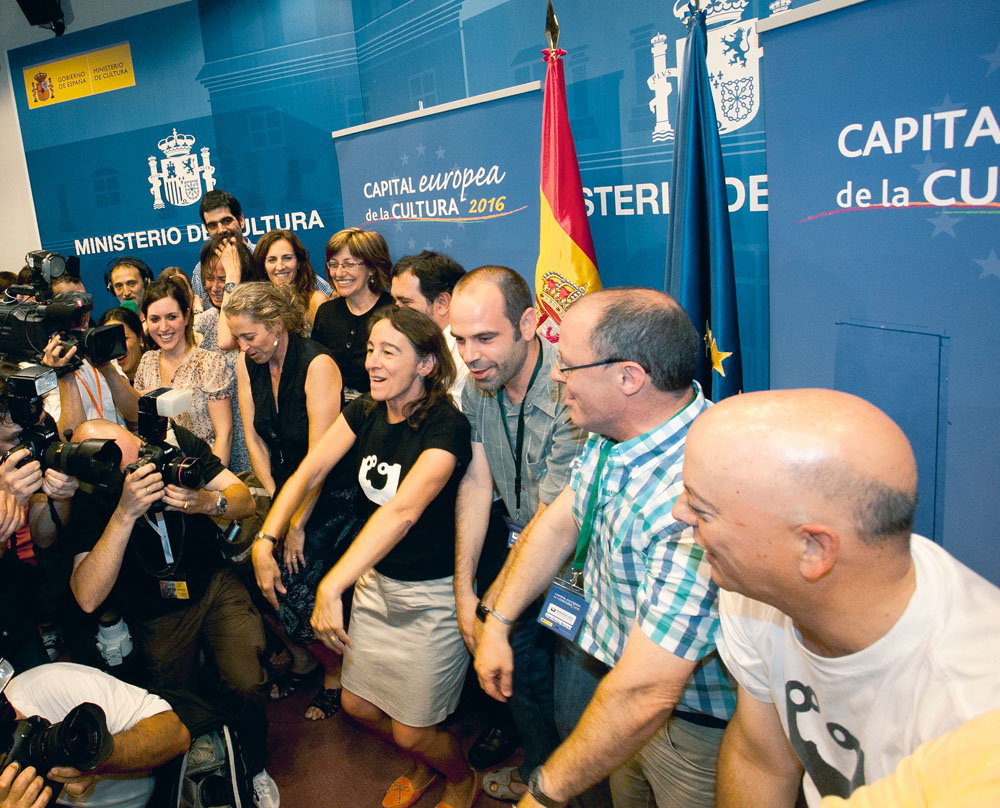
Odón and I didn't know each other. He read the pillars of my Basque Journal and one day he called me: ‘Listen, Santi, do you know what cultural capitals are?’ And I do. ‘They are the European Commission’s cultural value mechanisms, but it is basically related to the idea of tourism, the flow of capital and the idea of branded cities. I am not very interested in this concept, because it goes against culture, and I would advise you not to introduce it".
This is Santi Eraso's answer. He was the director of Culture of the DSS2016EU project and one of the leaders of the San Sebastian candidacy. The mayor of the time, Odón Elorza, proposed to turn around, develop a different point of view, and asked him to put it “positive.” Then the first two reports emerged: The power of the possible [Power of the possible] (2008) and The cultural bubble. Education/ecology/culture: a new social trinomial [Cultural bubble. Education/ecology/culture: new social trinomial] (2009).
The initial project departed from these works. “Culture was not seen as a mass spectacle, as a tourist attraction, as a list of the famous ones that come,” says Eraso. “We wanted to foster local culture. The tourist didn’t matter to us.”
They sought broad participation in the elaboration of the first two documents, “almost all the programs and projects were proposed by the people: associations, collectives and private individuals”. For Eraso, “although it was the typical idea made by a mayor to be remembered, from the beginning consensus was sought and it achieved that of all parties. And also of some people from the Abertzale left [at that time the Abertzale left was illegalized and had no representatives in the city hall].”
Change without change
But in June 2011, what no one expected happened. The newly created Bildu coalition won the municipal elections in San Sebastian and the new mayor was Juan Karlos Izagirre. Shortly thereafter, on 29 June, San Sebastian was designated European Capital of Culture.
The rest of the Spanish candidatures generated a great stir, due to the pruritus that caused them to win Bildu. According to Eraso, Bildu “accepted the document” and “had to guide” the project. Igor Otxoa was then incorporated as project manager.
According to Otxoa, he worked as a “bridge” between those who worked until then the project and the new government. “The paper held everything” and it was up to them to “fix the runway”.

Bildu, “noraeza” and “boycott”
Attempts, “the project started adrift.” Eraso states that, on the one hand, it was clear that no one truly believed in the fundamentals: “We won against desire.” But, on the other hand, it acknowledges that the Izagirre corporation suffered a “boycott”. For
Otxoa it is also noteworthy: “Everyone wanted to use 2016 politically to move. It is curious, because Zinemaldia has the same participants who were in the board, for example, and that does not happen in it. I had a lot of expectation and a lot of media load.”
Eraso has further clarified: “At the time of Bildu all the sponsors were withdrawn. There was a lot of pressure. The same happened when I was in the office of Manuela Carmen [former mayor of Madrid], boycotted by the media and the economic powers. Bildu did the same. Bildu had to rule against the storm, he said it perfectly. They did what they could. Like Pablo Berastegi, what he could.”
Itziar Nogeras highlighted the “persecution” they did with the former director of Donostia 2016: “It was a reputable campaign, and I was kicked off like in Madrid. Since then, everything has been a nonsense. Broken agreements, withdrawn sponsorships, media against … That was also the evolution of El Diario Vasco. At first shy, then when Bildu went all the way against, and when Eneko [Goia] entered, they dipped in, but it was too late…”
The European Union, in its official valuation report, also notes that: “Bildu’s political views on the EU strategy did not coincide with those of national and regional governments, resulting in instability in programme management (and changes in key staff, including the coordinator).” The European Union itself acknowledges that the programme suffered “negative and difficult media monitoring”, “as well as some political scandals in the design and implementation phase among the means of political motivation”.
Bildu, in principle, “wasn’t clear what he wanted to use for 2016,” and this affected the workers who had projects: five workers at first, thirteen in 2014, 39 in 2015, until they reached 61 in 2016. This lack of investment generated tensions with Europe.
Polemics and resignations
In January 2011, the Donostia Foundation 2016 was established, led by Eva Salaberria. The Foundation was formed by the Basque Government, the Provincial Council of Gipuzkoa and the City Hall of San Sebastian. Subsequently, the Spanish Ministry of Culture, in exercise of its right, decided to include a member of the board of trustees.
About two months after the foundation, the artistic director Ainara Martín resigned for “personal reasons”. In July of the same year, Fernando Bernues was appointed his alternate.
Santi Eraso was one of the first people to abandon the project. In 2011, when the project was won, he lived in Seville and, since his recognition, he did not see “compatible to return to San Sebastian”. By then, Igor Otxoa was the project director.
The most controversial was that of Itziar Nogeras, in summer 2013. Bildu proposed to him when he was working at Elhuyar. After approval, the public competition was launched. The ABC newspaper published a farewell letter sent by Nogeras to his colleagues before the competition was held.
The Spanish Ministry of Culture asked for explanations, the bustle was on the table. All the parties met in a meeting, the procedure was approved and Nogeras was elected unanimously. Shortly afterwards, he was abandoned by Fernando Bernues and later by Igor Otxoa.
The bustle lasted and finally Nogeras decided to leave office denouncing the “partisan use” of the project. And also “lack of trust,” citing Mayor Izagirre. Xabi Paya, Enara García and Garbiñe Muñoa took the lead provisionally until Pablo Berastegi was elected final director. This also raised powders because Bildu chose a director who didn't know Euskera.
According to Eraso, “Pablo Berastegi was able with what was left of the project he did. A project of this kind cannot be asked too much, given its lack of direction. He was dismantled, and he took the crumbs. With the cuts that were made, it could not be done otherwise.”
Eneko Goia and normality
Eneko Goia won the elections in 2015 and formed a government with the PSE-EE in the City Hall of San Sebastian. As a result of the implementation of the stand-by projects, sponsorships reappeared: The Kutxa Foundation contributed 500,000 euros to San Sebastian 2016, becoming the “global sponsor” of the capital. The sponsorships of Telefónica, Iberdrola and large companies were also included.
At the end of 2015, the programme was officially presented in Tabakalera: 102 projects designed and developed with 500 cultural agents and artists were presented.
Cold and txistus at the opening
The opening ceremony was one of the most prestigious events in 2016. Above all, once again, because of the controversy. Goia himself acknowledged that “he did not comply with the forecasts” and that Denis Itxaso left him “cold”. Faced with this, the responsible artist, Hansel Cereza, showed his discomfort and did not accept the criticisms.
In addition to the show on the bridge, the budget also sparked the debate. In fact, in March 2016, it was still not clear how much was spent on the exercise. The initial cost was €660,000. Given that this was a half-hour show, EUR 22,000 per minute. If the concepts of “design and creation of the inaugural act” and “production of the inaugural act” are added, the amount of the event amounted to 800.053 euros. The opening of the four days resulted in a total expenditure of EUR 2,825,046, as could be read in the documentation published by Ahal Duguk.
Weeks earlier, on San Sebastian Day, the controversy took place. He had intended to play and sing the European anthem, but a great Txistu was heard, which joined the semi-organised initiative. Television broadcast it live.
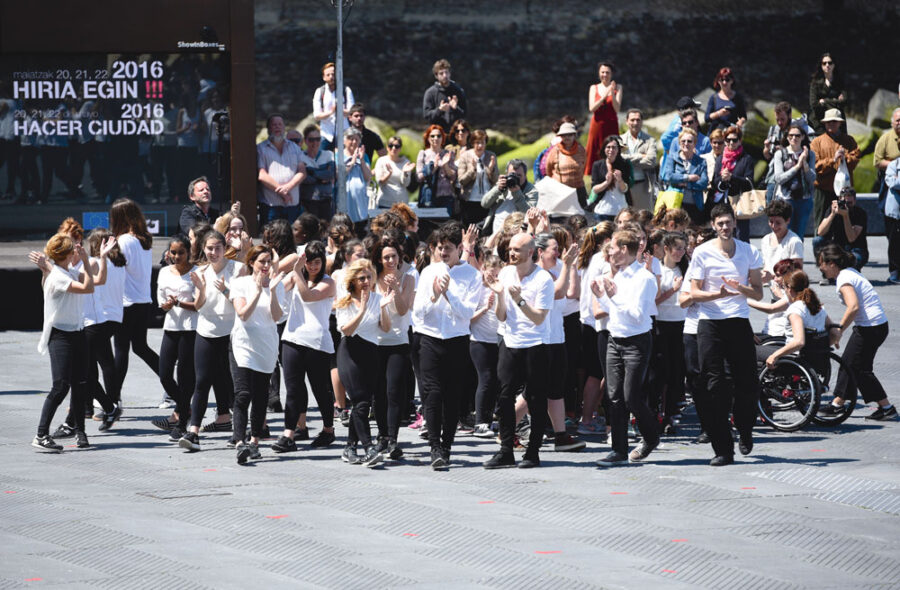
Comprehensive programme for the whole year
Beyond the ups and downs, following the initial intentions, 2016 was filled with acts focusing mainly on the central neighborhoods of San Sebastian. The distribution of the events was as follows: Egia 22.5%, Centro 21%, Parte Vieja 19%, Gros 11% and Antigua 4.5%.In 2016, 3,356 activities
were organized, 6.8 daily activities. Of them 2,476 in Donostia and the rest in Gipuzkoa.
The programming was developed from a “deseasonalization” approach that sought moments of less prominence in the official cultural offer of San Sebastian. Thus, the highlight of the offer of capital activities were May (453 activities) and October (470), months in which the high season of San Sebastian is not summer.
Breakwater for ten years
The activities related to cultural capitality were divided into three headlights: Faro de la Paz, Faro de la Vida and Faro de las Voces. Each one of them had a specific line, and within each one of them twenty activities were carried out. On the other hand, they created the Piers to work in a transversal way the objectives: plurilingualism, technology, critical thinking, contemporary art, participation, artists and cultural spaces.

The European Union report acknowledges the work of 2,373 volunteers who spent 10,493 hours. Considering that the Behobia-San Sebastián brings together more than 1,000 volunteers in one day, this is not a very high number.
The Breakwater was one of the most unique projects. The festival was created in 2010, when the cultural capital was still in the application phase. The last one took place in 2020, with about 60,000 participants in the 200 activities of the festival.
Corchoenea and the city model
As of 2016, most of the bridges of coexistence between popular movements and cultural capitality were broken. The same week that it opened in Tabakalera, in September 2015, excavators broke some of the Corchoenea cheese mill. In the absence of judicial authorization, the demolition had to be delayed. The conflict was evident in the concert of the feminist group Pottors and Klito hardcore at the opening ceremony of Tabakalera.

Tabakalera wanted to start the act on women and claim, but he said it clearly: “This is not what we wanted to imagine.” Amaia Gabilondo of the group will stain the body with red paint and that of Kultura herria. He opened the banner of Corchoenea Bizirik. “Art is being said to be for everyone, and today we are angry because we have done what we have done,” Gabilondo said.
The fight against the demolition of the Corchoenea cheese factory brought back weeks. The 2016 workers supported Koroenea and numerous cultural agents from Donostia and Euskal Herria. Tabakalera himself, through a bird, gave his support to the young man, and the former director, Xabi Paya, supported him in an article.
Finally, in November 2015, gaztetxe Koroenea was thrown down. From September to November he organized the city's largest cultural offer, with concerts of groups of the size of Fermin Muguruza, Glaukoma, Berri Txarrak, Zea Mays, Pearls and Anari, among others.
Peace and coexistence
One of the most ambitious was the draft Peace Treaty. Philip VI. It includes the visit of the newly appointed King of Spain. A group of artists criticized their participation in the marquees. The City Hall declared its falsehood, but the artists replied no, that the welcome to the king of Spain was real.
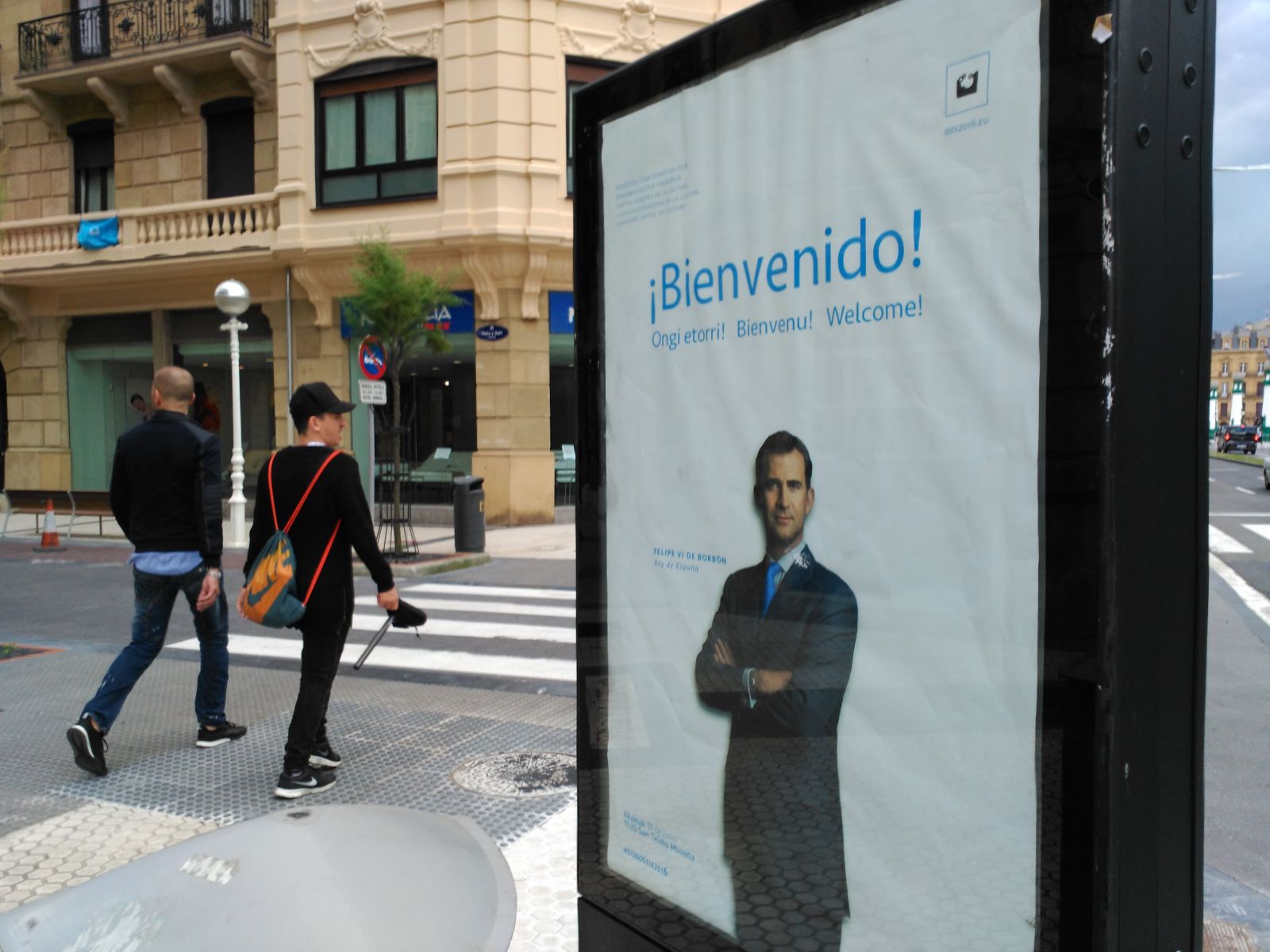
Eraso was the CEO of this project. For him, “He had a vocation to be the axis of the final account of ETA’s violence. Because it encompassed almost the entire history of art.” He began with the work of Bruegel, “the town is holding a party, but with a pool in the middle. To remember that absolute peace leads to state violence.”
If we ask about the 2016 contribution to coexistence, Eraso has given importance to the process: “The same process of building the project became a space for dialogue. The encounter between different was a laboratory. That was enough and left for me: Reach agreements between the PP and Bildu, look!”

He also highlighted the project (E) real dialogues, with a memorable dialogue between Ramón Saizarbitoria and Fernando Aranburu, among others.
Consensus of all parties
The criticism, the conflict, the conflict, Eraso is right when he says that 2016 achieved the consensus of the parties. Although in the policies that led to the PSE-EE, Bildu and the PNV there was a conflict, in the base no one questioned the project itself. In short, because they were all part of one way or another of the project.
The Desokupatu 2016 movement was one of the few that from the beginning criticized the situation. Without leaving the controversy, here too. For example, one of the first interventions by Santi Eraso was organized in the gaztetxe Koroenea, when words such as gentrification in the dictionary of popular movement were not yet available, and the gaztetxe lock was sabotaged. That there was controversy, that was a consensus.
Igor Otxoa believes it was “a great contradiction”: “We talked about coexistence, but then everything was very difficult.” In 2015, “Corchoenea’s demolition also showed that cultural capitality did not change some basic things.” He has also recalled the existing censorship, “it is quite the opposite of the understanding of the culture that I have” [In the exhibition No room, without time it refers to the censorship of the work of art of a Basque prisoner].
“It could have been something else,” according to Otxoa: “Because at first we all sought to develop a popular culture that would transform it from the base.”
What is the legacy?
Otxoa sees the situation from a distance and believes that nobody wants to return to the topic: “Time has passed and there should be a real investigation into the consequences left behind.”
According to Eraso, “I wanted to be a ten-year process, with 2016 being a turning point. The idea was the process, the path. Not the event. But in the end it became an act.” Asked about the legacy, Eraso responds without hair in her mouth: “As far as I know, there is no legacy. People wanted to spend 2016 with a little embarrassment. Because what had to be a green option became brown.”
In May 2006, the City organized a conference at the San Telmo Museum to publicize the great cultural projects of San Sebastian. In it were presented the Victoria Eugenia Theatre, the San Telmo Museum and Tabakalera. The Victoria Eugenia Theatre was opened in March 2007. San... [+]
Iazko abenduko egun bat izan zen, larunbat goiza. Ahoz aho zabaldutako informazioari esker izan nuen filmaren proiekzioaren berri eta kulturgune batera joan nintzen, Donostian, gauza handirik jakin gabe: zer ikusiko genuen pantailan, sarrerarik ordaindu behar ote zen, zenbat... [+]
Jaurlaritzarentzat momentu egokia dirudi probatzeko ea kulturaren gauza honek balio duen normalizazio sozial eta politikoa lortu izana poltsikoratzeko ere.
Europako hizkuntza gutxituetako hiztunen eskubideak bermatzeko sortu da Donostiako Protokoloa. Kursaal Jauregian egin dute honen aurkezpena. Kontseiluak eta Donostia Fundazioak sustatutako proiektuak 185 neurri ditu bere baitan.
Larunbatean, 11:30ean hasita zuzenean ikusi ahal izango da zuzenean ARGIAn.
Hizkuntza Eskubideak Bermatzeko Protokoloa Europako 50 bat hizkuntza komunitatetako ehundik gora eragilek sinatu dute. Abenduaren 17an, ekimenaren bultzatzaileek, Donostia 2016 Europako Kultur Hiriburuak eta Kontseiluak, Donostian aurkeztuko dute. ARGIAk streaming bidez... [+]
Donostia 2016 Europako Kultur Hiriburutzak zentsuratutako lan batzuk Antiguako Txantxarreka gaztetxean jarriko dituzte ikusgai larunbatean.
Espetxeetan eta zentro psikiatrikoetan dauden pertsonek egindako lanak biltzen dituen erakusketa batetik erretiratu ditu antolakuntzak euskal presoei zegozkienak: "Biktimei min eman diezaiekegu".
Donostiako udaletxearen aurrean protesta egin dute kolektibo eta eragile ugarik deituta, Demokrazia Zuzenaren Foro Globalaren irekiera ekitaldia baliatuz. “Donostia ez da eredugarria demokrazian, Donostiako Udalak jardunaldi hauen aurkezpenean dioen bezala”.
Donostiako udaletxearen aurrean protesta gisa kontzentrazioa deitu dute azaroaren 16an hiriko hainbat taldek: Satorralaia, Errausketaren Aurkako Mugimendua, SOS Miracruz 19, Stop Desahucios, Eleak/Libre, LAB. EH Bildu eta Ahal Duguk ere babesa adierazi dute. Egun horretan... [+]
Europako Kultur Hiriburutzaren aurkako Donostia Saldu eta Suntsitu kolektiboak, Letaman gaztetxeak eta hainbat musika taldek festa antolatu dute azaroaren 19an, Intxaurrondoko gaztetxean bertan. Jakinarazi dutenez, Mozal Legearen ondorioz, hirian 7.000 eurotik gorako isunak... [+]










